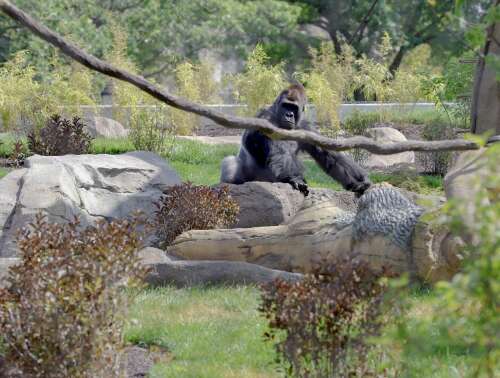The new “James & Elizabeth Bramsen Tropical Forests” outdoor primate complex at Brookfield Zoo Chicago opens to the public today.
Brian Hill/[email protected]
The gorilla climbed to her sunny perch to munch on a snack and hang out with her female companions.
That moment might not sound as thrilling as an encounter with the greatest of great apes, the alpha male silverback. But in the life of this family troop, it’s no less extraordinary.
Jontu and his gorilla tribe now have free rein of an expansive, verdant space — the grand finale of “Tropical Forests,” the new outdoor primate complex ushering in an era of transformation at Brookfield Zoo Chicago.
“This $66 million project, the largest and most ambitious in Brookfield Zoo Chicago’s history, has officially and quite literally come to life over the last few weeks as our animals have moved in,” said Dr. Michael Adkesson, president and CEO. “It’s a monumental achievement.”
Visitors to Brookfield Zoo Chicago’s “Tropical Forests” get a close-up view of a gorilla.
Brian Hill/[email protected]
An outdoor trail snakes around four areas designed for not one but two gorilla troops, orangutans and smaller primate species. Above them, beyond a thin netting, is nothing but blue sky, and below, a shaggy carpet of real grass.
“Perhaps most moving of all for some of our gorillas and our orangutans born here at the zoo, this is the first time that they’ve had an environment where they can feel the grass under their feet, the sun coming down on their face, and the breeze moving through their hair,” Adkesson said.
When “Tropical Forests” opens to the public Friday, it may be the first time zoo visitors come in such close proximity to western lowland gorillas and a troop leader like Jontu (JOHN-too), an amazing creature — all muscle — with a way of making his presence known. In yet another milestone, the zoo now has its first bachelor gorilla group, brothers Shango and Barney, with their own pad.
Among the project’s most impressive stats? About 2,700 square feet of glass viewing panels. You’ll feel like a kid again stepping up to a picture window inside an artificial tree trunk.
Barney is part of Brookfield Zoo Chicago’s first bachelor troop.
Courtesy of © Brookfield Zoo Chicago
“I’m keenly aware of this incredible animal that is directly behind me that I’m sure is stealing your gaze away from me, but that’s what we want,” Adkesson said with gorillas roaming in the backdrop to a gathering of zoo benefactors and dignitaries Thursday. “That’s what this is all about.”
Dr. Michael Adkesson, president & CEO of Brookfield Zoo Chicago, and other leaders cut the ribbon for “Tropical Forests” Thursday morning.
Brian Hill/[email protected]
That’s part of the ethos behind the “Next Century Plan” to reimagine the zoo campus as you know it. “Tropical Forests” is hailed as the capstone project for the first phase of that plan, a “bold, 30-year vision and 15-year road map for the future of Brookfield Zoo Chicago, said Cherryl Thomas, chair of its board of trustees.
“This opening marks the close of phase one and the beginning of so much more to come,” she said.
Inspiring connection
Though next to each other, “Tropical Forests” is a world away from its predecessor, “Tropic World,” a 1980s-era primate building known for its scale, thunderstorm sound effects and other man-made features. There’s a much larger degree of separation inside that building.
But at the entrance to “Tropical Forests,” vocal monkeys move directly overhead in a long chute.
A monkey navigates a tunnel at Brookfield Zoo Chicago’s “Tropical Forests” Thursday.
Brian Hill/[email protected]
“Those moments spark something,” Adkesson said. “They build empathy, they inspire connection, and they can be the first and most important step towards conservation action, actions that lead to protecting wildlife and the natural world that they depend on.”
Brookfield Zoo Chicago visitors come face-to-face with great apes Thursday.
Brian Hill/[email protected]
The zoo also encourages that stewardship in more explicit ways at a time when two-thirds of primate species, Adkesson said, are threatened with extinction. Patrons are invited to recycle old cellphones at a drop-off station inside the new Gorilla Conservation Center, helping reduce demand for coltan, a mineral mined in gorilla habitats. “Tropical Forests” is also home to spider monkeys rescued from wildlife trafficking.
“We have 10 spider monkeys that will be in the very first habitat as you come into the space, and five of those 10 were a recent confiscation by U.S. Fish and Wildlife Service that were being trafficked out of South America into the United States to be sold as pets,” Adkesson said. “Obviously, they don’t do well as pets. They’re a very complex, social animal that really needs to be with other monkeys.”
There’s also the element of choice. Animals can explore shady areas, waterfalls and streams, sloping terrain, misters for the hotter months and heated rocks for the colder ones.
“Microclimates within the different spaces allow them to be where they feel most comfortable,” Adkesson said. The zoo also has incorporated “dynamic enrichment devices that pop food out at different points throughout the day to keep the animals moving around, foraging as they would in the wild and really just enjoying the space.”
Looking ahead
The zoo is already starting the early design process for the next marquee project.
“We’re moving our sights from ‘Tropical Forests’ to 35 acres of the northwest quadrant of the zoo as we look at African savanna and African forests,” Adkesson said.
“Tropical Forests” spans nearly 3 acres. So the head veterinarian-turned-CEO felt “overwhelmed with a sense of awe and joy and gratitude for this space and the possibilities that lie ahead.”
“We’ve created something truly magnificent,” he said, “that will stand here for generations to come and inspire millions of guests that come through the park.”
